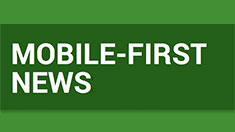
How mobile news notifications can benefit business—and democracy
Natalie “Talia” Stroud is an associate professor of communication studies, assistant director of research at the Annette Strauss Institute for Civic Life, and director of theEngaging News Project at the University of Texas at Austin.
With endless distractions (Candy Crush, anyone?), news organizations are struggling to capture the public’s attention. How to do it without being too disruptive (i.e. annoying) is the key.
One way that news organizations are trying to remedy this problem is with mobile news notifications, which alert users when breaking news is happening. The brief headlines that flash on a phone’s lock screen provide a snippet of newsworthy events. These mobile notifications, also known as push notifications, are a way for news organizations to directly reach mobile audiences, rather than waiting for them to visit the organization’s website or app.
While these notifications are becoming increasingly popular with news organizations, there’s still much we don’t know about them. For example, what exactly is the business benefit? Newsrooms know how many people allow notifications, but it’s not always possible to track whether notifications drive people to the news organization’s app or website. If notifications don’t push people to news products, then do they have revenue implications? Or are they just a perk for loyal audiences who download the app and say yes to receiving alerts?
Notifications are also interesting from a democratic angle. They represent an opportunity for incidental exposure, or encounters with the news when one wasn’t intending to seek news. But it’s not clear whether mobile notifications help to inform the public, or if the snippets only provide information to those who would have heard the news via some other source.
We at the Engaging News Project sought to answer some of these questions. With the support of Knight Foundation, we analyzed what happens when people allow mobile notifications on their smartphones. The results show that people who receive notifications do, in fact, visit a news organization’s app more than those who do not sign up for notifications.
For the study, the Engaging News Project conducted a two-wave experiment with 420 participants. In the pre-wave, we asked participants to download, at random, the CNN app, the BuzzFeed News app, or the E! news app. We also asked them, again at random, either to allow or to not allow notifications. About two weeks later, we re-contacted study participants and asked them to tell us more about their experience with the app and notifications.
Twenty-seven percent of those asked to install the app with notifications reported using it daily or more often compared to 12 percent of those asked to install the app without notifications. Plus, more than 56 percent of respondents who received notifications said that they went to the news organization’s website to learn more about a notification they had received.
We also found that notifications significantly increased knowledge in some instances. Those assigned to receive CNN notifications were more knowledgeable about CNN notification content than other participants, including those assigned to download the CNN app without allowing notifications. We asked study participants three knowledge questions about the notifications sent by CNN, but not by BuzzFeed News or E! News. Forty percent of those assigned to receive CNN news notifications answered all three of these knowledge questions correctly; only 20 percent of those in the other experimental conditions did so. We asked other knowledge questions, but there weren’t any differences based on which app people installed or whether they were asked to install notifications. Additional findings can be found in our report.
What our research tells us is that there appear to be business and democratic benefits to news organizations using mobile news notifications, as people who receive notifications are more likely to visit a news organization’s app. However, more research is needed to better understand best practices for sending news notifications.
Email Natalie Stroud via [email protected].
R
-
Community Impact / Article
-
Community Impact / Article
-
Information and Society / Report
-
Community Impact / Article
Recent Content
-
Community Impactarticle ·
-
Community Impactarticle ·
-
Community Impactarticle ·





